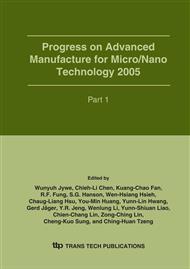p.361
p.367
p.373
p.379
p.385
p.391
p.397
p.403
p.409
Temperature Effect on Tensile Behavior of Helical Multi-Shell Gold Nanowires
Abstract:
This study performs molecular dynamics (MD) simulations to investigate the tensile behavior of Helical Multi-Shell (HMS) gold nanowires. As their name suggests, these nanowires have a multi-shell helical structure rather than a conventional bulk FCC structure. The mechanical properties and deformation behaviors of the 7-1, 11-4 and 14-7-1 HMS structures are examined under tensile testing at temperatures between 4K and 300 K and a constant strain rate of 0.003% −1 ps . The results reveal that temperature influences the yielding stress, the Young’s modulus, and the deformation behaviors of HMS nanowires. The yielding stress of the 7-1 structure is found to be higher than that of the 11-4 or 14-7-1 structures. Finally, under different temperature conditions, many different close-packed structures are identified in the nanowires before they fracture.
Info:
Periodical:
Pages:
385-390
Citation:
Online since:
January 2006
Authors:
Price:
Сopyright:
© 2006 Trans Tech Publications Ltd. All Rights Reserved
Share:
Citation:


